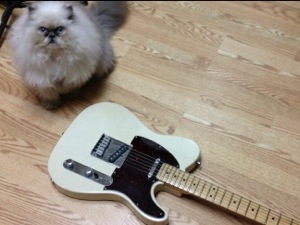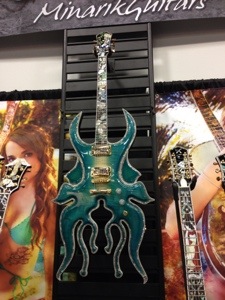Often I am asked, “What is a good guitar for a beginner? How much should I spend? Are some brands better than others? What else will I need to buy?” These are valid questions for both beginners and parents of soon to be beginners. I thought I’d tackle this question head on.
What is a good guitar for a beginner?
A “good” guitar for a beginner is a subjective term, but I will try to address the points you need to know to determine the baseline for quality in a guitar. Beginners are often directed by what the eye tells them. A cooler body shape, or a favorite color can sway a beginner’s choice in ways that are sometimes not so good. So, to remove some of this problem, I suggest viewing the various shapes available and narrowing your search to only the shapes you prefer. Do the same with color, so you can look at each guitar objectively. (Examples of common body styles: Fender Stratocaster or Strat, Fender Telecaster or Tele, Gibson SG, Gibson Les Paul, Gibson Explorer, Gibson ES-335, Gibson ES-175, Dean Razorback, Dean ML, Gibson Flying V, Jackson Offset V, Jackson King V, BC Rich Mockingbird, and more wild shapes like the Minarik Medusa, BC Rich Warlock, or the multitudes of custom shapes). Once you know the shape and color, finding the guitar to suit your needs becomes simple math. In general, nearly all students choosing electric guitar start with the Strat, Tele, SG or Les Paul style guitars. These are available in an incredibly wide price range and can be found in those shapes to fit any budget. Now, here it is important to know that guitars that look identical can be several thousand dollars different in price. There is a reason for this. It is not what you see, but what you hear that matters most.
Sabella the Tip Cat shows us a Fender Telecaster
Gibson Les Paul
From mild to wild, the Minarik Orchid
Today, an intermediate bass student came in ready to upgrade from his former Squire daily driver. After narrowing the choices down to a couple Yamaha 4-string basses, he took them both for a test drive. The prices of the two basses were $225 and $510, and it was up to him to decide which he preferred. In this case, the cheaper bass had a great finish, so it came down completely to sound and feel. It took him just a few notes to determine which one felt and sounded better. The cheaper bass was appealing to the eye, but the rougher finish on the neck and the passive pickups offered a cheaper feel and much less tonal warmth. The more expensive bass offered better fit and finish, as well as active pickups which gave him greater control over the shape of his tone. He immediately noted the difference and recognized that the sound was worth the extra cash in the long run. All in all, the process was very fast. He knew he wanted a four string, and that was about it. The first step was to determine the level of bass he is looking for. Choosing a price before you look is important to keep things that are too spendy off your radar. If you play a $3000 bass before you look at the $500 basses in your price range, you will hate them all. The next step was plugging a few in and feeling them out. Ultimately, he made a good decision and followed his ear to the edge of his budget. Often, solid advice is to get the best instrument you can afford. In some cases, it’s best to invest more cautiously as you determine if guitar is an instrument for you.
How much should I spend?
This is a tricky area, so I’ll be as short and sweet as possible. It is very difficult to find a sufficient electric for under $200. There are many on the market for much less, but in general these are of such inferior quality that a potential guitarist may be turned off to the instrument completely. I would expect to spend about $400 or more to be sure you have a good, playable instrument that plays in tune and will hold up over the next few years of learning. It can be done for less, however it takes a patient and discerning eye to find them. Almost no line of budget guitar has good enough quality control to buy one blindly, say from the Internet. I have only bought one guitar without playing it before hand, and that was a Gibson. I trusted and hoped they would meet my standards with a random selection. Luckily they did, however at NAMM this year I played two Gibsons by random selection and found them both substandard. So, I got lucky as not all Gibsons are going to feel and play the same, or even up to par. Extremely inexpensive, import guitars are often lacking in build quality, parts quality, and quality control.
Are some brands better than others?
Absolutely. Yes. That is a matter of personal preference, though. The big names in guitar (Gibson, Fender, ESP, Schecter, Ibanez, BC Rich, Jackson, Yamaha, Paul Reed Smith, Dean, Gretsch, etc.) all have a full range of instruments from entry level to professional custom models. Each brand caters to a type of player. Fender players usually aren’t the same guitarists playing an Ibanez. They are both quality instruments, but aimed at different players. Now, you can pretty much play any guitar in any style, but a guitar dedicated to being easy to play fast is going to be preferred by a speed player, where a guitar dedicated to its tone might be the first choice of a blues player. Many brands offer quality instruments at good price. The bottom line is what feels best in your hand and sounds good to your ear is the brand you are looking for. For me, that is Minarik guitars, specifically a super custom Minarik Medusa. Feel and sound are my main priorities. Weight, color and body style are almost irrelevant for me, however the guitar I found that sounded and played best for me also happened to be an artistic, visual statement. Win win.
What else will I need to buy?
Here is where it is important to make sure you have the necessities to ensure you are able to enjoy and protect your investment. Number one: get a good case. What’s a good case? The more protection the better. I recommend a hard case. Gig bags are good for carrying your guitar on your back, but offer little protection from impact, and your guitar will never come out of the case in tune. For a beginner, this alone can be very frustrating. You will also most likely need picks, a strap (any strap will do for now. They can be expensive and a $10 strap will do the job), an instrument cable (no less than 10 feet, 20 feet is better), and an amp (reverb is a wonderful thing, so do yourself a favor and try to make sure you at least have some reverb). All these extras will add up to another $150-200, so be prepared. They are necessary, and you spend double later for what you skimp on now.
My guitar ownership history at a glance.
My first guitar was a no name $50 classical back in 1981ish. It broke of its own accord in about a month. It was just too cheap. My second was a no name (Sonora) ES-335 copy. Never sounded good. Never really played good. I didn’t get a better guitar for another 10 years. I still learned the guitar, but it really slowed my progress in retrospect. My next was to be a Korean made Ibanez solid body, strat style guitar. Worked well and did the job to learn what playing guitar really meant. It was getting that guitar that set me on the path as a career guitarist. I practiced, studied and learned everything I could. Fast forward another 10 years, and I buy my first American Fender Standard Stratocaster (1998). Life changed dramatically there, and in 1999, I got an American Standard Fender Telecaster with an ash body. These two guitars became my main workhorses for many years. In 2007, I picked up an endorsement deal with Minarik guitars and found my guitar soulmate “Elise”. (Minarik Medusa Custom). Since then, I’ve picked up a vintage Gibson SG, a Les Paul, a number of other Minariks and a few miscellaneous guitars. The moral is, buy what’s right for you now, and upgrade in the future as you grow as a player. A $10,000 guitar will not make you awesome. Practice makes you awesome, the guitar will just let you shine once you’re polished.
Best bets under $600:
Minarik Lotus Studio Extreme (In my opinion, these are the best playing guitar on the market under $600, hands down. I own two. I prefer it over my American Standard Ash Telecaster which retails around $1,400.)
Fender Stratocaster (Made in Mexico)
Fender Telecaster (Made in Mexico)
Epiphone Les Paul
Epiphone SG
Worth looking into:
Schecter
Ltd
Charvel


